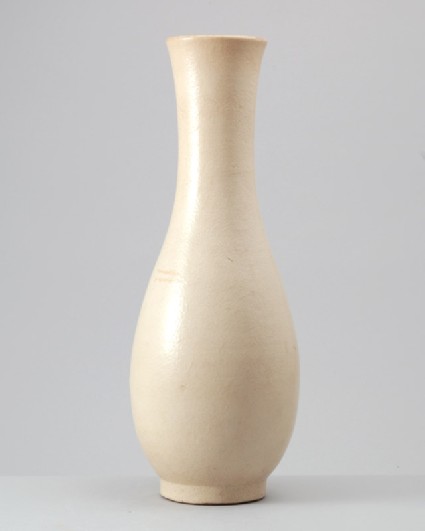The Barlow Collection
A select catalogue of the Barlow collection of Chinese Ceramics, Bronzes and Jades by the University of Sussex (published Sussex, 2006).

Publications online: 456 objects
Show search helpWhite ware vase in the style of Dehua ware
- loan
-
Literature notes
Wares of this cream-glazed crackled ware were formerly compared to Song dynasty (AD 960–1279) Ding ware from Hebei province, and on account of their softer body became known as tu Ding (‘earthen Ding’). They are probably, however, not copying earlier Ding but contemporary Dehua wares made somewhat further north in the same province, which are renowned for their fine white porcelain.
The tall slender vase is very heavily potted, with an ovoid body, wide, slightly waisted neck and a thick, straight foot. The body which has stained to a buff colour, is covered with a thick opaque cream-coloured glaze with an overall fine-meshed crackle, which in places has reddish-brown stains. -
Details
- Associated place
-
Asia › China › Fujian province (place of creation)
- Date
-
17th century (1601 - 1700)
Ming Dynasty (1368 - 1644)
- Material and technique
- stoneware, thrown, with white glaze
- Dimensions
-
41.2 cm (height)
14.1 cm (diameter)
at foot 9.2 cm (diameter)
- Material index
- Technique index
- Object type index
- No. of items
- 1
- Credit line
- Lent by the Sir Alan Barlow Collection Trust.
- Accession no.
- LI1301.65
-
Further reading
University of Sussex, and Arts and Humanities Research Council, The Barlow Collection, supervised by Regina Krahl, Maurice Howard, and Aiden Leeves (Sussex: University of Sussex, 2006), no. C31
Glossary (2)
glaze, stoneware
-
glaze
Vitreous coating applied to the surface of a ceramic to make it impermeable or for decorative effect.
-
stoneware
Ceramic material made of clay which is fired to a temperature of c.1200-1300⁰c and is often buff or grey in colour.
Location
-
- currently in research collection
Objects are sometimes moved to a different location. Our object location data is usually updated on a monthly basis. Contact the Jameel Study Centre if you are planning to visit the museum to see a particular object on display, or would like to arrange an appointment to see an object in our reserve collections.
Publications online
-

The Barlow Collection
Wares of this cream-glazed crackled ware were formerly compared to Song dynasty (AD 960–1279) Ding ware from Hebei province, and on account of their softer body became known as tu Ding (‘earthen Ding’). They are probably, however, not copying earlier Ding but contemporary Dehua wares made somewhat further north in the same province, which are renowned for their fine white porcelain.
The tall slender vase is very heavily potted, with an ovoid body, wide, slightly waisted neck and a thick, straight foot. The body which has stained to a buff colour, is covered with a thick opaque cream-coloured glaze with an overall fine-meshed crackle, which in places has reddish-brown stains.
Notice
Object information may not accurately reflect the actual contents of the original publication, since our online objects contain current information held in our collections database. Click on 'buy this publication' to purchase printed versions of our online publications, where available, or contact the Jameel Study Centre to arrange access to books on our collections that are now out of print.
© 2013 University of Oxford - Ashmolean Museum



